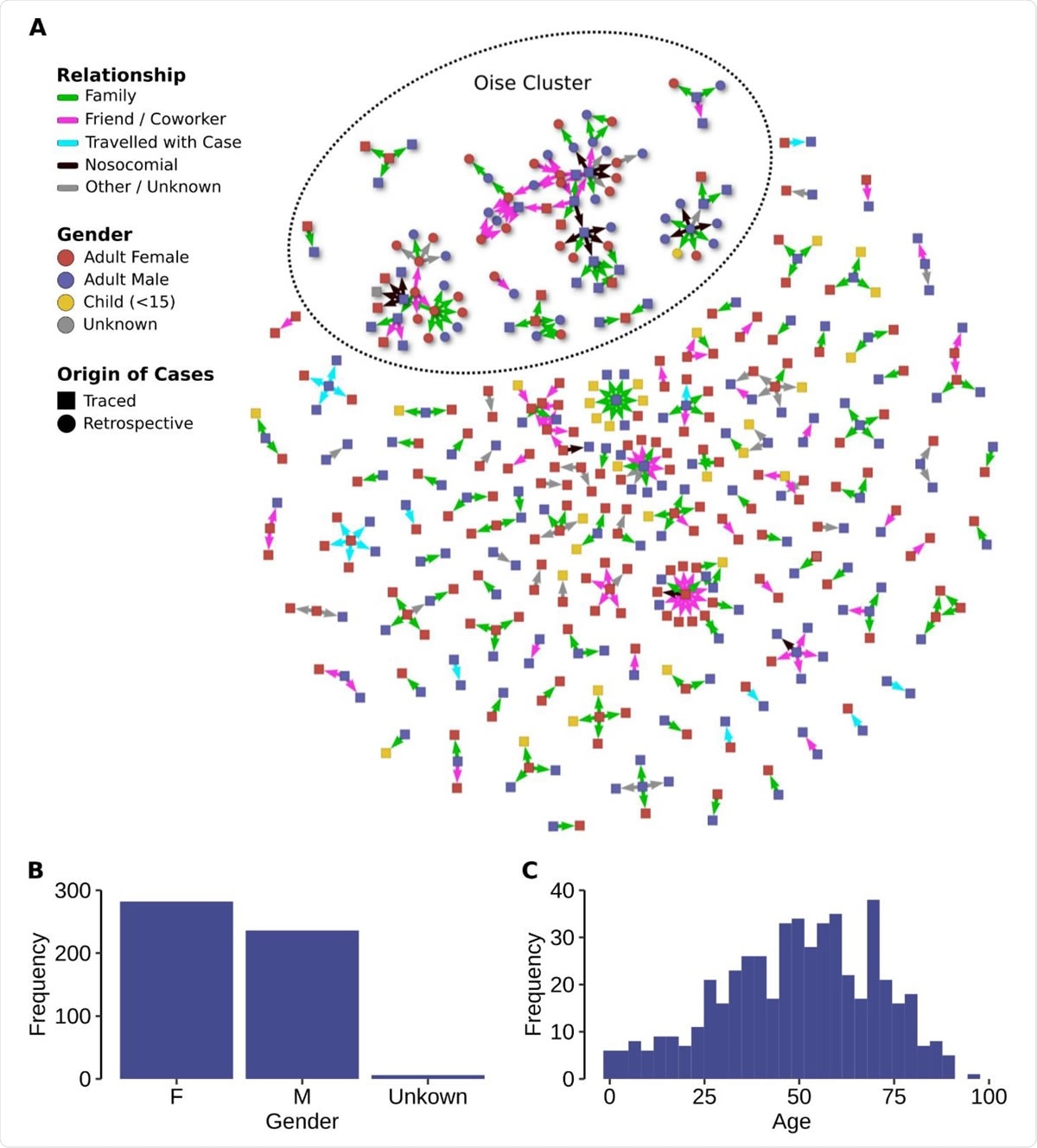By using data from epidemiological investigations and contact-tracing efforts during the initial phase of the coronavirus disease (COVID-19) epidemic in France, researchers were able to appraise secondary clinical attack rates and factors associated with the risk of a contact becoming a case. Their findings are currently available in a medRxiv* preprint paper.
The severe acute respiratory syndrome coronavirus 2 (SARS-CoV-2), a causative agent of the COVID-19 pandemic, has spread rapidly across the world since it emerged in Wuhan, China. The main reason is its swift spread from person to person via the respiratory route.
During the early phase of the epidemic, France made a substantial effort to contain the virus's importation into its territory. In January 2020, a steadfast surveillance system was already implemented country-wide that enabled early detection of cases and contacts but also slowed the spread of the virus and halted secondary transmission events.
Such contact tracing represents an indispensable tool for controlling epidemics and has proven efficient in the past. However, its use can also improve the knowledge on the natural history of emerging pathogens (such as SARS-CoV-2) and their transmission dynamics.
Consequently, a French group of researchers, led by Dr. Paireau Juliette from the Institute Pasteur in Paris, aimed to assess secondary clinical attack rates and to pinpoint risk factors that play a role in contacts becoming cases, but also to estimate chains of transmission and key parameters of viral spread.

Chains of transmission. (A) Observed transmission chains. Only confirmed cases/contacts involved in a chain with at least one confirmed case are represented. (B) Distribution of sex. (C) Distribution of age.

 This news article was a review of a preliminary scientific report that had not undergone peer-review at the time of publication. Since its initial publication, the scientific report has now been peer reviewed and accepted for publication in a Scientific Journal. Links to the preliminary and peer-reviewed reports are available in the Sources section at the bottom of this article. View Sources
This news article was a review of a preliminary scientific report that had not undergone peer-review at the time of publication. Since its initial publication, the scientific report has now been peer reviewed and accepted for publication in a Scientific Journal. Links to the preliminary and peer-reviewed reports are available in the Sources section at the bottom of this article. View Sources
Making use of the stringent surveillance system
In this study, the researchers have analyzed detailed data gathered during retrospective outbreak investigations and contact tracing in the early phase of the epidemic in France – more specifically, from 24 January 2020 until 30 March 2020, two weeks after lockdown.
The data was used to assess secondary clinical attack rates in detail and characterize the risk of contact becoming a case among 6,082 contacts of 735 index cases. Furthermore, chains of transmission have been described, with the subsequent estimation of key parameters of spread among 328 infector/infectee pairs.
Protocols and case definitions evolved during the study period in order to adjust to the changing epidemic situation while new knowledge on SARS-CoV-2 and its transmission has emerged. After collection, all data were entered into a secure web-based application.
Unveiling the importance of superspreaders
This study found an overall secondary clinical attack rate of 4.1%, which significantly increased with age of the index case and of the contact. Family contacts were at much higher risk of becoming cases, whereas contacts in the hospital were at lower risk in comparison to coworkers or friends.
Moreover, the distribution of secondary cases was very over-dispersed, with 80% of secondary cases arising due to only 10% of cases. The mean serial interval was 5.1 days in contact-tracing pairs, consistent with published estimates of 4 to 6 days obtained in similar contexts of case isolation.
Finally, the mean number of secondary cases associated with every index case was 0.3-0.9. These values are lower than the estimates for the reproduction number of SARS-CoV-2 in the absence of any interventions or population immunity, which is usually between 2.5 and 3.
Valuable lessons for epidemiologists
This study definitely contributes to refining our knowledge of SARS-CoV-2 transmission, especially considering the significance of superspreading events with all accompanying implications for control efforts.
"In our study population, we found that the risk of becoming a case was more than twice higher for contacts older than 45 years compared to 15-29 years old", highlight study authors in this medRxiv paper.
"Interestingly, the age-specific contact patterns observed in our study before cases are isolated were very consistent with those obtained in a large-scale population survey conducted in France in 2012", they add.
Despite the colossal efforts needed for performing contact tracing during outbreak events, proper collection and analysis of this type of data is pivotal for improved understanding of disease transmission and tailoring highly efficient control strategies.

 This news article was a review of a preliminary scientific report that had not undergone peer-review at the time of publication. Since its initial publication, the scientific report has now been peer reviewed and accepted for publication in a Scientific Journal. Links to the preliminary and peer-reviewed reports are available in the Sources section at the bottom of this article. View Sources
This news article was a review of a preliminary scientific report that had not undergone peer-review at the time of publication. Since its initial publication, the scientific report has now been peer reviewed and accepted for publication in a Scientific Journal. Links to the preliminary and peer-reviewed reports are available in the Sources section at the bottom of this article. View Sources
Journal references:
- Preliminary scientific report.
Paireau, J. et al. (2020). Early chains of transmission of COVID-19 in France. medRxiv. https://doi.org/10.1101/2020.11.17.20232264, https://www.medrxiv.org/content/10.1101/2020.11.17.20232264v1
- Peer reviewed and published scientific report.
Paireau, Juliette, Alexandra Mailles, Catherine Eisenhauer, Franck de Laval, François Delon, Paolo Bosetti, Henrik Salje, Valérie Pontiès, and Simon Cauchemez. 2022. “Early Chains of Transmission of COVID-19 in France, January to March 2020.” Eurosurveillance 27 (6). https://doi.org/10.2807/1560-7917.es.2022.27.6.2001953. https://www.eurosurveillance.org/content/10.2807/1560-7917.ES.2022.27.6.2001953.